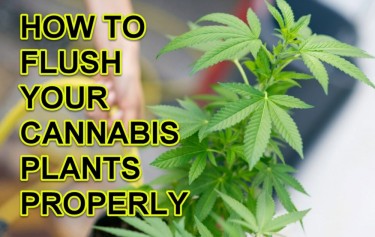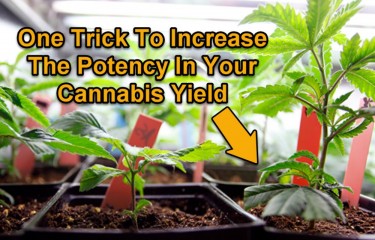
To flush or not to flush
If you grow cannabis, you have probably heard that you should always flush before harvest. Heck, even I wrote about flush and why it’s important to create a smooth puff and tasty smoke … it turns out I can possibly be wrong about all of this!
Oops!
Of course, when I first started growing cannabis that was the lesson of the country and I think I just accepted it for truth, as thousands of home growers have in the past. Recently, Ed Rosenthal and Dr. Robb – two legendary names in cannabis cultivation – asked for their thoughts on the flush in a Reddit AMA.
That’s what they had to say;
Dr. Robb;
Ed and I have very similar feelings about flushing. Many people will claim that you need to flush to avoid smoking too heavily. Well, this hypothesis is easy to test in the industry right now. A plant grown in a 1 or 2 gallon rockwool or coconut-coconut container can be easily flushed at the end of the grow cycle. Well, what about cultivators growing in giant 200 gallon containers or in the ground in the Mendo or Humboldt counties in the Emerald Triangle? You could never completely flush your growing media, but its bloom is just as smooth as any flower grown indoors (as long as they’re both properly cured).
Science is the best way to get these answers, and knowledge is power. Scientia potentia est!
Edit: Ed and I both agree that since science shows little to no difference in yield, potency, and general quality of flowers that have been rinsed compared to flowers that have not been rinsed, they are just as well rinsed could. This will save you money on nutrients and will not affect the quality and quantity of the bloom. – REDDIT-AMA
A Redditor interjected, pointing out that Dr. Robb contains many unreliable variables. The good doctor followed quickly;
A study was carried out.
It says pretty much the same as what we mentioned in the previous comment, but here’s the summary of the report:
-Rx Green Technologies studied the effects of different flush times on the chemical profile, taste and smoking properties of cannabis flowers.
– Cherry Diesel was given flush times of 14, 10, 7 and 0 days.
– No differences between the flush treatments in terms of yield, potency or terpenes were found.
– Analysis of the mineral content of the leaves showed small changes in the iron and zinc content.
– Taste test panelists tended to prefer the flower rinsed for 0 days.
In other words, there isn’t really a noticeable difference between the two, and when it comes to Rosenthal and Dr. Robb leaves – both agree: “If there is no difference, then flushing is fine because it reduces the need for nutrients.” That means flushing doesn’t affect the buds themselves, but it could be a more cost-effective strategy as you save nutrients.
For small growers this might not be a significant cost, but as you grow your farm the savings would add to the overtime. There’s an incentive to flush, it’s just not what you thought it was.
Some redditors also pointed out this study, which has been completed;
Three treatments; Control (watering events every 1-2 days), light stress (watering events every 2 days), and moderate stress (watering events every 3 days) were tested. The effects of flushing were also studied to determine whether it had the intended effect of reducing nutrient levels in the dried flowers. Through the use of psychrometers, the threshold values for the water condition (cWP) were correlated with the threshold values for the humidity (cVPD) and the frequency of irrigation was reduced, which led to a reduction in water consumption of up to 45.7%, which had negligible effects on the yield and had the cannabinoid profile. Flushing was found to be ineffective in removing significant amounts of nutrients from the flowers.
Now that we’ve nipped the flushing debate in the bud, let’s take a look at a few other key questions answered.
Question: What tips do you have for drying / hardening cannabis?
Drying and curing is the most important step in the entire production. You can be the best grower on the planet, but your flower will be worthless if it is not a good nose. As soon as you harvest your crop, you immediately switch from terpene production mode to terpene retention mode. Some of the monoterpenes in cannabis begin to volatilize at temperatures as low as 70 ° C, so it is important to get your crop into a controlled environment as soon as possible after it is harvested. For a traditional dry space, you need steady air movement, ~ 55% RH, and 60 ° F for the surrounding area, but it’s important to get it into a cool, dark area as soon as possible.
Ed says, “I’m a big fan of a CryoCure drying product. They use a freeze drying method and their terpene retention is better than anything I’ve seen. The taste is great, but most of all the smoke is smooth. The CryoCure method was based based on observations from my earlier version of the Cannabis Grower’s Handbook using a standard low-vacuum freezer for freeze-drying. Your new technology, however, is much more sophisticated now. ” – Doctor Robsenthall (Rosenthal + Robb)
Question: What do you think of modern strains? Are they really more potent than what we’ve been able to grow in the past? Are there any ancient strains or terpene profiles that you are missing?
Ed says, “Most of the old strains (cultivars) are still available. Any grower who misses the old strains can find them on the internet. I miss seeing the NL5 Haze available, but that’s mostly due to the 12th -Week-time plant. “
Dr. Robb says, “Many cannabis growers focus on producing THC from their new breeds. THC is a 21 carbon plant. So if a new breed’s genetics encourage THC production, there will be less carbon available for other cannabinoids and terpenes. Modern strains may have higher levels of THC, but that is usually at the expense of other more desirable products in the plant. The carbon balance is determined by the genetics of the plant. So when genetics boost THC production, there is less carbon available to everything else. “
Question: Can you let these Reddit guys know shwazzing is okay and not plant torture?
Schwazzing is absolutely ok. There are a number of reasons why it works (carbon distribution, increased light penetration through the canopy, etc.) but the only aspect where Schwazing benefits the plant is that cannabinoid and terpene production are closely genetically related to it to respond to environmental stress. Giving a little stress without reducing photosynthesis too drastically will benefit the plant. The perfect example of how hard love can benefit a plant other than cannabis is date palms. Date palms are like cannabis in that they have separated male and female plants. Ancient date palm farmers wanted both males and females to flower at the same time in order to increase pollination and thus their fruit yields. They learned that if they physically whipped the trunks of the palm trees, they could make the plants bloom at the same time and more strongly.
Question: How do you feel about the HPS / LED argument? Is one better than the other?
Ed says: “The most important thing about working with lights is the DLI (Daily Light Integral). This is the amount of light the plants receive over a 24 hour period. The main factor related to luminaires is their efficiency in producing the most amount of light per watt consumed. HPS lamps used to be considered the most efficient lamp for this reason, but some LEDs now produce more light per watt than HPS lamps. The efficiency is usually given in joules. The higher the number, the higher the light per watt. LEDs vary significantly, but efficiency is the main factor when choosing the lamp for your grow. There are some caveats, though: some lamps like Hortilux and California Light produce light that is out of range PAR range but are known to increase growth as the red increases in the spectrum, which has been shown to power photosynthesis as well. Also UV, which stimulates THC production. We have an easy-to-read table in the Cannabis Grower’s Handbook of LED lamps with their efficiencies. “
Dr. Robb says, “We also just ran a test on some lamps comparing CMH and HPS. The gGRO CMH lamp outperformed lamps such as the Nanolux CMH and the Luxx HPS lamp over the gGRO lamp. I was pretty overwhelmed with their performance. “
Question: What is the best way to focus on maximizing the taste and smell of the final product?
Ed says, “It’s important to harvest at the right time to optimize the terpene levels in the buds. This should be done in the early ripening phase when the trichome’s glands are just beginning to change color. Do a study to scientifically determine when that time actually is, but traditionally this is when you harvest. “
Dr. Says Robb, “When you are harvesting at the optimal time, the most important thing is to move the harvest to a cool, dark, dry room as soon as possible. If you can smell the plant, it means that it is terpenes that have volatilized the flower and are no longer retained in it. The retention of terpenes is important as some of the monoterpenes can volatilize at temperatures as low as 70 ° F. Your dry room should be 60 ° F or so. “
The sticky end result:
If you want to examine the rest of the answers, there is a lot of gold in it. I just fished out some of the key questions, but there are plenty of comments from Redditors that also offer some serious insight. I hope this helps clear up the whole flushing debacle.
MORE ABOUT THE FLUSHING, READ THIS …

HOW DO YOU RINSE YOUR MARIJUANA CORRECTLY?
OR..

CANNABIS TAKE POTENTIAL TRICK, A FLUSH? READ THIS!

Post a comment: